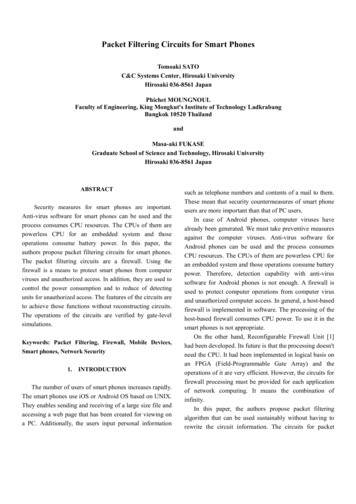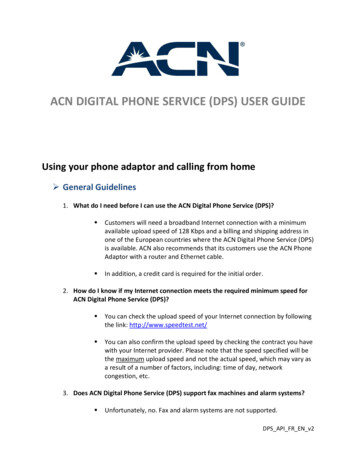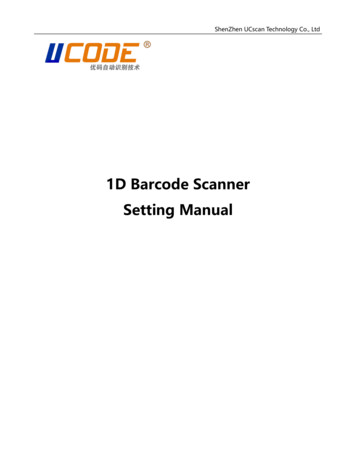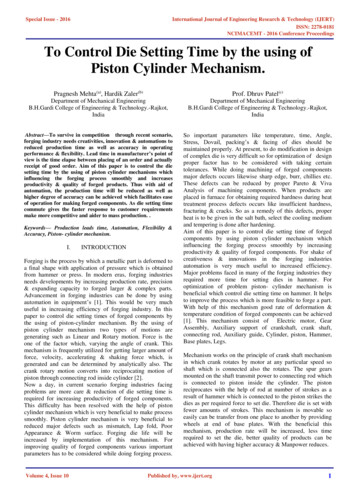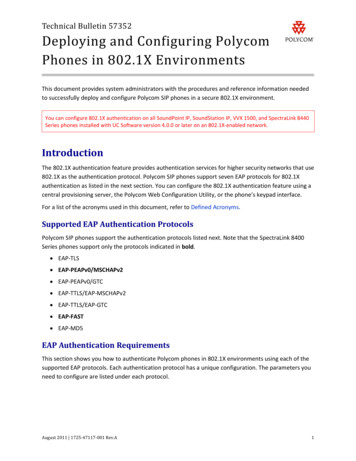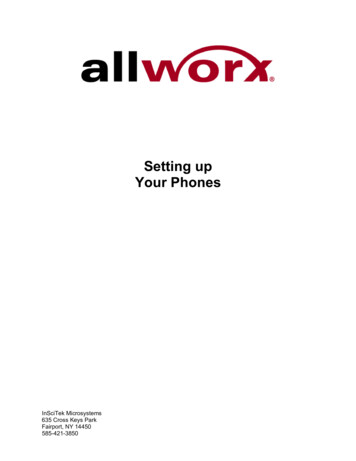
Transcription
Setting upYour PhonesInSciTek Microsystems635 Cross Keys ParkFairport, NY 14450585-421-3850
Table of ContentsSetting up Your Phones . 1How to Add an Analog Handset . 2How to Add a SIP Handset. 3How to Add a User and Assign an Extension . 4How to Add a System Extension . 6How to Set up or Change Call Routing . 8How to Define the Outside Lines. 12
Setting Up Your PhonesSetting up Your PhonesYou’re ready to set up the phones for users on the Allworx system. To do this, you’ll: Add Analog or SIP handsets Add the Users and assign extensions Add System Extensions Set up or Change Call Routing Define the Outside LinesYou’ll need this much timeSetting up your phones on the Allworx system will take about an hour.Gather This InformationYou’ll need the following information: The types of phone (analog or SIP) your company will be using. A list of users and the extensions you would like for each to have. A list of preferences of how users would like their calls routed according to theirpresence (location, activity, status of phone, etc.) A list of system extensions (such as phones in conference rooms, break rooms, etc.)Before You BeginInstall the Allworx hardware. Mount the server where it will reside. Plug in the power cable. Plug in the phone line(s) from the service provider. These lines may be Central Office(CO) or Direct Inward Dialing (DID) lines. Plug in the handset for each user. Plug in the Ethernet cable for your PC into one of the LAN ports.Prepare to send information to users about their Usernames and passwords, and extensions.1
Setting Up Your PhonesHow to Add an Analog Handset1. Expand Phone System and click Handsets.Handsets page2. Make sure that the analog handset is plugged into an analog port (4 – 16) on the Allworx server.It’s a good idea to plug the first phone into port 16, the next one into port 15, etc, workingbackwards toward port 4. Lift the receiver so that the phone is “off hook.” Click Scan for New.Scan For New Handsets page3. The handsets you plugged in will appear on the Handsets page.4. Hang up the receiver.2
Setting Up Your PhonesHow to Add a SIP Handset1. Expand Phone System and click Handsets.Handsets page2. When a SIP phone is connected to the Allworx server, it will automatically be set up as a plugand-play handset. These will appear on the list of handsets with “MAC” addresses in theIdentification field.3. Restart the phone by disconnecting its power supply, waiting 10 seconds, then reconnecting it.3
Setting Up Your PhonesHow to Add a User and Assign an ExtensionWhen finished, make sure you send the Login Name, Password, and Primary Extension information toeach user.1. Expand Business and click Users.Users page2. Click Add New User.Add New User page3. Enter: Login Name: the user will use this to log in to the client application Full Name: First, Middle, and Last Password: the initial default password which the user can later change. This password isused for logging in to the client application and for accessing voicemail.4. Select a Primary Extension. This is the number that someone will dial to reach this user.5. Select the Phone Assignment that matches the phone.4
Setting Up Your Phones6. Check the System Features for the user: Enable Voicemail: Creates a voice mailbox for the user. Select the maximum number ofmessages for the mailbox. POP3 Email Access: Enables the user to access their email remotely. Allow other users to view calendar: The user can change this, if desired. Enable Dial-by-Directory listing: If enabled, the user is included in the directory for callers.7. Select the maximum size of the Universal Inbox where email and voicemail messages will besaved as part of the Unified Messaging feature.8. Click Add.9. The user appears on the list. For example:Users page with example10. Click the person icon before each name to see the Welcome page for each user.Sample User Welcome page5
Setting Up Your PhonesHow to Add a System Extension1. Expand Phone System and click Extensions.Extensions page2. Click Add New Extension.Add Extension page6
Setting Up Your Phones3. Select the extension you want to use as a system extension.4. Enter a Description of the system extension. For example, First Floor Conference Room.5. To set up the call routing for the system extension, click add a connection attempt.a. Select the phone for the extension.b. Select the number of rings that will sound on the phone before another action will take place.c.Select the type of ring for the extension. In the list, a dot means a short ring and a dash meansa long ring.d. To have the incoming call ring at more than one phone, click add a phone. Select a phone,number of rings, and type of ring for each phone.6. To add more call routings, click add a connection attempt. Repeat step 4 for each addition callrouting.To remove a call routing, click delete this attempt for the connection.7. Select the next action when all call routings have been exhausted: Hang up without taking any further action Transfer to Auto Attendant Transfer to Voicemail for user and select the user who should receive the voicemail Dial number to transfer the call to another extension or outside number8. Click Add. The new system extension appears on the Extensions page.7
Setting Up Your PhonesHow to Set up or Change Call RoutingWhen a call comes in for a user or system extension, it follows a path, or route, that has been set up forthe extension. The routes are determined according to the user’s status or the extension status, such as ifthe line is busy or unanswered. For example, if a call comes in for a user who is attending a meeting, thecall could be routed to her voicemail or could be routed to another extension where someone else couldhandle the call. If a call comes in to a system extension in a conference room that is busy, it could berouted to the operator.Call routes can be setup for individual users, telephones, or extensions and are based on events. Callscan also be routed according to the caller, if Caller ID is used. For example, calls from certain area codesmay be routed to certain phones.1. Expand Phone System and click Extensions.Extensions page8
Setting Up Your Phones2. Click View Call Routes for the extension for which you want to establish a Call Route.For user extensions, the call routes for each presence are shown.Call Routes for User Extensions pageFor system extensions, the call routes are shown.Call Routes for System Extensions page9
Setting Up Your Phones3. Click New Call Route to create a new route or click Modify to change an existing Call Route.New Call Route page4. For a user extension, check add this new route to all the user’s presences if you want to addthis route for all presences.For a system extension, you can change the description of the extension.5. If you’re creating a new route, select the call origination: External – Caller ID number if you want calls from this number to be specially routed.You can enter an area code, area code plus prefix, or a complete number. Internal – phones owned by if you want to change what happens when the call comesfrom a specific extension.If you’re modifying an existing route, select: Modify Primary Route if you want to change what happens when the call first comes in. Modify On Busy Route if you want to change what happens when the primary route isbusy.10
Setting Up Your Phones6. To set up the Call Route, click add a connection attempt.a. Select the phone for the extension.b. Select the number of rings that will sound on the phone before another action will take place.c.Select the type of ring for the extension.d. To have the incoming call ring at more than one phone, click add a phone. Select a phone,number of rings, and type of ring for each phone.7. To add more call routings, click add a connection attempt. Repeat step 6 for each additionalCall Route.To remove a call routing, click delete this attempt for the connection.8. Select the next action when all call routings have been exhausted: Hang up without taking any further action Transfer to Auto Attendant Transfer to Voicemail for user and select the user who should receive the voicemail Dial number to transfer the call to another extension or outside number9. Click Update.11
Setting Up Your PhonesHow to Define the Outside Lines1. Expand Phone System and click Outside Lines.Outside Lines pageAll sixteen ports are visible and available for configuration. Ports 1 through 3 can only be used for loop start business lines. Ports 4 through 9 can be used for either business lines or DID lines. Ports 10 through 16 may only be used for DID lines.12
Setting Up Your Phones2. Click Modify to set up an Outside Line.Modify Outside Line page3. Enter a Description and select the port.4. Add prefix digits if: The phone company in your area requires additional numbers to be dialed when accessingtheir services. More than one PBX is used (i.e., the systems are cascaded together).Enter the access digits as the Prefix Digits. Include the digits that the phone company orcascaded PBX requires but don’t include the 9 that you normally need to access Allworx.5. Select where calls that come in on this line should be initially routed: Extension – all incoming calls are route to the selected extension Auto Attendant – calls are routed to the selected Auto Attendant Voicemail for user – calls are routed to the selected voice mail6. Click Update.7. Repeat steps 2 – 6 for each Outside Line.13
Expand Phone System and click Handsets. Handsets page 2. When a SIP phone is connected to the Allworx server, it will automatically be set up as a plug-and-play handset. These will appear on the list of handsets with "MAC" addresses in the Identification field. 3. Restart the phone by disconnecting its power supply, waiting 10 seconds, then .




